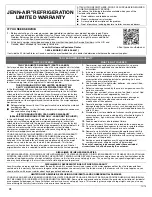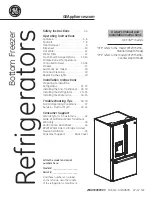
14
REFRIGERATOR CARE
Cleaning
WARNING
Explosion Hazard
Use nonflammable cleaner.
Failure to do so can result in death, explosion, or fire.
Both the refrigerator and freezer sections defrost automatically.
However, clean both sections about once a month to avoid
build-up of odors. Wipe up spills immediately.
To Clean Your Refrigerator:
1.
Remove the top grille. See “Power On/Off Switch.”
2.
Press power switch to OFF.
3.
Remove all removable parts from inside, such as shelves,
crispers, etc.
4.
Hand wash, rinse, and dry removable parts and interior
surfaces thoroughly. Use a clean sponge or soft cloth and a
mild detergent in warm water.
■
Do not use abrasive or harsh cleaners such as window
sprays, scouring cleansers, flammable fluids, cleaning
waxes, concentrated detergents, bleaches or cleansers
containing petroleum products on plastic parts, interior
and door liners or gaskets. Do not use paper towels,
scouring pads, or other harsh cleaning tools. These can
scratch or damage materials.
■
To help remove odors, you can wash interior walls with a
mixture of warm water and baking soda (2 tbs to 1 qt
[26 g to 0.95 L] of water).
5.
Wash stainless steel and painted metal exteriors with a clean
sponge or soft cloth and a mild detergent in warm water. Do
not use abrasive or harsh cleaners, or cleaners containing
chlorine. Dry thoroughly with a soft cloth.
6.
Clean the condenser coils located behind the top grille
ventilation panel regularly. Coils may need to be cleaned as
often as every other month. This may help save energy.
■
Use a vacuum cleaner with an extended attachment to
clean the condenser coils when they are dusty or dirty.
7.
Press the power switch to ON.
8.
Replace the top grille. See “Power On/Off Switch.”
Lights
The lights in both the refrigerator and freezer compartments
are LEDs which do not need to be replaced. If the lights do not
illuminate when the door is opened, call
1-800-536-6247
for
assistance or service.
Power Interruptions
If the power will be out for 24 hours or less, keep the door or
doors closed (depending on your model) to help food stay cold
and frozen.
If the power will be out for more than 24 hours, do one of the
following:
■
Remove all frozen food and store it in a frozen food locker.
■
Place 2 lbs (907 g) of dry ice in the freezer for every cubic foot
(28 L) of freezer space. This will keep the food frozen for 2 to
4 days.
■
If neither a food locker nor dry ice is available, consume or
can perishable food at once.
REMEMBER:
A full freezer stays cold longer than a partially filled
one. A freezer full of meat stays cold longer than a freezer full of
baked goods. If you see that food contains ice crystals, it may be
refrozen, although the quality and flavor may be affected. If the
condition of the food is poor, dispose of it.
Vacation Care
Your refrigerator is equipped with the Sabbath Mode feature,
which is designed for the traveler who wishes to turn off the lights
and ice maker. By selecting this feature, the temperature set
points remain unchanged, the ice maker will be disabled and the
interior lights will turn off. For most efficient refrigerator operation,
it is recommended to exit Sabbath Mode when it is no longer
required.
If You Choose To Leave the Refrigerator On While
You’re Away:
1.
Use up any perishables and freeze other items.
2.
Press SABBATH.
3.
If your refrigerator has an automatic ice maker, shut off water
supply to the ice maker.
4.
Empty the ice bin.
5.
When you return from vacation, press SABBATH to return to
normal operation.
If You Choose To Turn the Refrigerator Off Before You Leave:
1.
Remove all food from the refrigerator.
2.
If your refrigerator has an automatic ice maker:
■
Turn off the water supply to the ice maker at least one day
ahead of time.
■
When the last load of ice drops, raise the wire shutoff arm
to the OFF (up) position.
3.
Depending on your model, turn the Thermostat Control (or
Refrigerator Control) to OFF. See “Using the Controls.”
4.
Clean refrigerator, wipe it, and dry well.
5.
Tape rubber or wood blocks to the tops of both doors to prop
them open far enough for air to get in. This stops odor and
mold from building up.















































